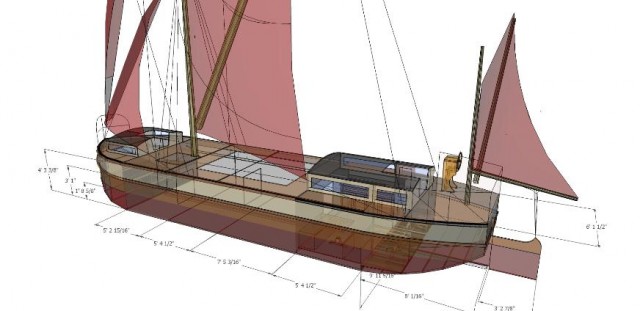Erik Andrus and the rest of the Vermont Sail Freight advocates are working hard to reinvent the way we ship our non-perishable goods: by sail boat. But perhaps “reinvent” is not the most appropriate word, but rather “revisit,” as sail freight barges were once a common way (actually, the most common, depending on the era) to ship goods, commodities and materials.
But why even bother? Isn’t this type of freight transportation slower, outdated and less popular?
Maybe so, but one Vermont farmer has been hard at work on changing this mentality. As an environmental advocate and one who recognizes the state of our energy-wasting, fossil-fuel consuming nation, Andrus believes in the importance of weening our society off of highway- and rail-freight dependency. By reintroducing the sail barge, Andrus is hoping to prove to the world that environmentally-friendly water vessels can be just as efficient, if not more, in the way we transport today’s cargo.
He asks, “why do non-perishable food products need to move down the interstate at 75 miles an hour?” Which addresses a good point: what’s the rush? At the cost of the environment and our health, do we, as a society, truly need to move our shelf-stable food products in a manner of such urgency? Though shipping freight by sail may currently be a slower, outdated and less popular form of transportation, Andrus says that more importantly, when compared to other conventional means of shipment, sail freight is, above all else, practical.
[youtube http://www.youtube.com/watch?v=bP-x0SzLoyM?feature=player_detailpage&w=640&h=360]

Still under construction, the premier sailing barge, “Ceres”–appropriately named after the the Roman goddess of grain and agriculture–is projected to make its debut voyage in September of this year. Using the Champlain Canal and Hudson River as its water highway and wind as its fuel, Ceres will travel from Ferrisburgh, Vermont to New York City, where it is expected to stop at docks and harbors along the way, including Mechanicsville landing, Troy, Albany, Hudson, Kingston, and Poughkeepsie.
The low carbon-footprint barge will carry as many as 12 tons of local, shelf-stable foods from the Champlain Valley. Included on board will be apples and cider syrup, wheat berries and stone ground flour, organic root vegetables and black beans, and short-grain japonica rice, along with pickles, salsas, and jellies. The Vermont Sail Freight Project is working on return cargo negotiations, which would allow the Ceres to bring food products from local businesses of the Lower Hudson region back up north to Vermont and the Champlain Valley – satisfying the elements that make up a traditional trade loop.
In the event where the Champlain Canal or the Hudson River do not provide enough winds for travel, the Ceres will also be equipped with a yuloh for sculling (or for the less nautically inclined, oars for rowing). At the very least, and as a last resort, the ship will be rigged with a motor propeller.
In addition, the barge has been retrofitted to accommodate for today’s “smart phone era,” as it will have an internet component that will allow for customers and fans to track down the barge’s location and progress through automatic updates via email, twitter, and text messages.
Though clearly a more environmentally-friendly means of shipping freight in the northeast, some critics may argue that a sailboat is not nearly as efficient. Where the barge may take a number of days to make a complete loop (Ferrisburgh, VT to NYC, and back), other, more typical forms of freight shipment, such as tractor-trailers and air-cargo, can complete the trip in under a day. How can high-demand businesses and consumers rely on a solitary cargo ship of limited freight capacity that can only make round trips once every other week?
When it comes to the future of how we ship our freight, it is this very way of thinking that Andrus is hoping to reverse. For non-perishable and shelf-safe goods, Andrus suggests, time sensitivity and arrival deadlines should be of little concern. Try to imagine a scenario where the Ceres becomes a whole fleet of “Ceres’s”–say 200 of them. Though it may take over a week for one sail vessel to make a loop from Vermont to NYC–therefore only hitting its destinations once every other week–if planned and calculated correctly, the other 199 barges will hit these destinations at all other times when the one is unable to. If planned and operated accurately and intelligently, a fleet of sail freight vessels could be just as efficient as our 18-wheelers and cargo planes.
And in this, maybe we can understand that the Vermont Sail Freight Project might not have been intended to simply “ooh and ahh” environmentally-conscious consumers and business owners down the Hudson as a hip fad where we can purchase local Vermont goods once in a while; rather, perhaps the intention was to start a freight revolution.
All images courtesy of the Vermont Sail Freight Project

